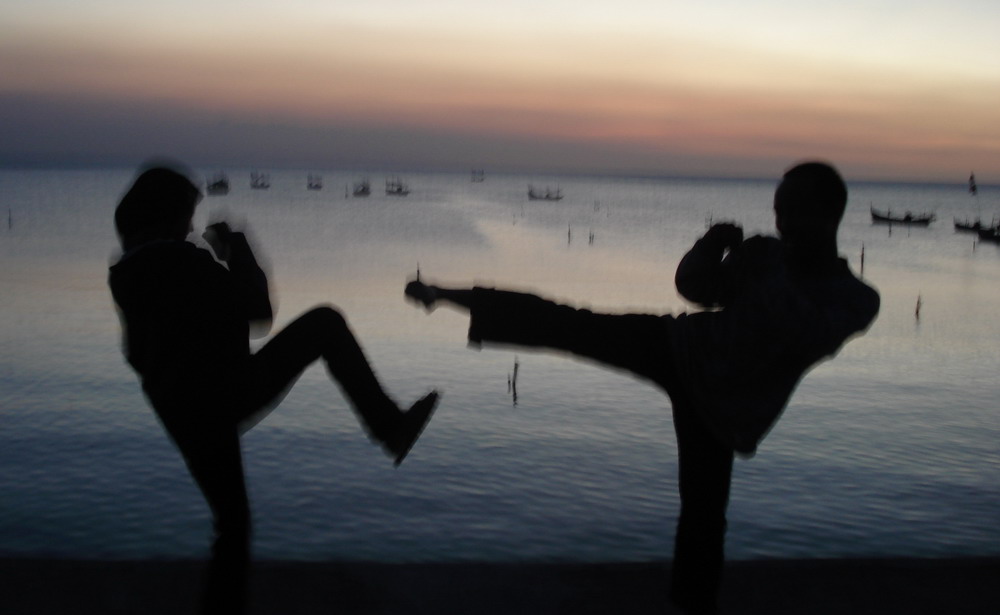Aquaculture Fisheries Development :
1. Preparation land
 |
| gracilaria sp |
Pond does not leak and can hold water with a minimum height of 35 cm water in the courtyard; Easy to replace the water with the tidal system, floodgates at good conditions to facilitate the replacement of water
b. Requirements of sea water
Not contaminated with pollutants; salinity between 15-32 ppt
2. Treatment pond (new pond)
a. Drying and processing of landDrying of 2-4 weeks old; Basic ponds are cracked; dug 15 cm deep soil and then reversed
b. Liming and fertilizing
Lime is spread in every land surface; dose of lime 500-1000 kg / ha; Fertilization 1000 kg / ha
c. Eradication of pests
Pest seaweed: fish tilapia; Pests of milk fish and shrimp: snapper, tilapia, tilapia fish
3. Planting and spreading
a. Density or planting of seedlings per hectareSeaweed 1 - 1.5 ton; 1.500 Milk fish; Shrimp 5.000
b. Terms of seed
Seaweed seedlings are young; Shrimp juvenile size; Milk fish size spindles, good quality
c. handling of seed
Before planting, seeds soaked seaweed in ponds for 2 hours; shrimp and milk fish adapted to temperature and salinity
d. Time spreading or planting seedlings
best time in the morning and evening, because at that time the water conditions are relatively stable; Seaweed is planted first, and after 7-10 days stocked milk fish seeds, 1 week later stocked shrimp seeds
4. period of cultivation
a. water substitutionSubstitution of water at least once every 2 weeks, depending on water conditions in ponds and in the channel; water is replaced by 30%
b. Monitoring / Sampling
Monitoring of growth and to estimate population
c. fertilization
Type of fertilizer used UREA / NPK; dose of 10 kg per week (done 5 times) during the cultivation
d. water quality monitoring
Temperature of 20-28 ° C; salinity 15-32 ppt; DO (dissolved oxygen) 3-8 ppm; brightness, the water is murky and can receive sunlight; The water level 30-50 cm
e. feed
Seaweeds absorb nutrients from sea water; milk fish eat benthos; shrimp consuming microorganisms (phytoplankton and zooplankton that live around seaweed)
f. Pest and disease control
White spot disease eradication by the turn of water, keeping the inlet sluice with a sieve, so that predatory fish are not entered into a cultivation pond
 |
| net Drying seaweed |
5. Harvest and post harvesting
a.time and size of the harvestseaweed harvested the first time after the age of 4 months; Milkfish size 250-300 grams; Shrimp size 35-40
b. Production /Ha/MT
1000-1500 kg dried seaweed; Milkfish 300 kg, 75 kg Shrimp
c. Drying seaweed
Dried for 3 days, aerated; Drying is done until the water content of approximately 18%; During the drying must be inverted back to dry evenly
d.Storage seaweed
Dried seaweed that has been included in the sack and then compressed and stored in a warehouse; sacks arranged in such a way, it is recommended not stick to the floor and walls of the warehouse
Aquaculture Fisheries Development









3 komentar:
Longchamp jjzneavg Longchamp Pas Cher wqjfihye Sac Longchamp adplxurp Longchamp Soldes ttbhismr Longchamps mtwwprrp
tory burch shoes sale tigucgsj Cheap Tory Burch shoes sdzebffv Tory Burch outlet online opjynmen discount Tory Burch shoes vmbqfdct Tory Burch outlet sale pkjihjaf Tory Burch Boots imcfmbcy Tory Burch Flats hbxiaazi Tory Burch Flip Flops hbhpzahv Tory Burch Handbags ghcgjwdp Tory Burch Heels dqsnoavr Tory Burch Reva Flats pqpuncni Tory Burch Sandals bmorjhzz Tory Burch Wallets ljmxqojc Tory Burch Wedges lwvfemcm
hollister france mgeqggxk hollister lyon vrykquhp hollister paris mhpuvbpc hollister pas cher usbpvlqj hollister soldes suyimoqj hollister xqpnxdop
Post a Comment